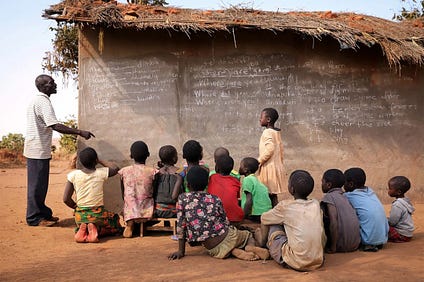DC and Maryland lead the US in early childhood education, new report reveals – WJLA

Report on Early Childhood Education Systems in the United States and Alignment with Sustainable Development Goals
A 2025 analysis of early education systems across the 50 states and the District of Columbia reveals significant disparities in progress towards Sustainable Development Goal 4 (SDG 4), which aims to ensure inclusive and equitable quality education for all. The findings highlight how leaders like Maryland and the District of Columbia are making substantial strides in achieving SDG Target 4.2: ensuring all children have access to quality early childhood development, care, and pre-primary education.
Evaluation Methodology and SDG Alignment
The assessment was based on three foundational pillars, each directly corresponding to key targets within the Sustainable Development Goals framework.
Access
This pillar measures the availability and reach of early education programs, a direct indicator of progress towards SDG 4, Target 4.2. It is evaluated based on:
- Share of School Districts that Offer State Pre-K Program
- Share of 3- and 4-year-olds Enrolled in State Pre-K Program
- Share of 3- and 4-year-olds Enrolled in Pre-K, Pre-K Special Education, and Head Start Programs
- Presence of Waiting Lists or Frozen Intake for Child Care Assistance
Quality
The quality of educational environments is critical for effective learning and aligns with SDG 4, Target 4.a, which calls for safe, non-violent, inclusive, and effective learning environments. Metrics include:
- Pre-K Quality Benchmarks Met
- Income Requirement for State Pre-K Eligibility
- Requirement of School Safety Plans & Audits
Resources & Economic Support
Financial investment is fundamental to building and sustaining quality education systems. This pillar reflects a state’s commitment to SDG 4 and contributes to SDG 10 (Reduced Inequalities) by ensuring that economic status is not a barrier to education. It is measured by:
- Total Reported Spending per Child Enrolled in Preschool
- Change in State Spending per Child Enrolled in Preschool
- Total State Head Start Program Spending per Child Enrolled in Preschool
- Monthly Child Care Co-Payment Fees as a Share of Family Income
State-Level Analysis: Leading Jurisdictions
Maryland: Rank 1
Maryland is ranked as the top state for early education, demonstrating a strong commitment to SDG 4. Its success is attributed to increased preschool enrollment and a robust investment in educational infrastructure. The state’s high ranking is supported by:
- High Investment: Maryland has the fourth-highest spending per child enrolled in preschool, at $17,262 annually.
- Commitment to Safety: The state mandates a statewide school safety plan with regular audits, directly addressing SDG Target 4.a by ensuring safe and effective learning environments.
- Enrollment Growth: The state has seen the 15th-highest increase in enrollment between the 2001-2002 and 2023-2024 school years.
District of Columbia: Rank 2
The District of Columbia demonstrates exemplary progress in achieving universal access to pre-primary education as outlined in SDG 4, Target 4.2. D.C. leads the nation in several key metrics:
- Highest Enrollment: D.C. has the highest share of three-year-olds (84%) and four-year-olds (95%) enrolled in pre-K, pre-K special education, or Head Start programs.
- Leading Financial Commitment: The District spends the most per child on preschool education, at nearly $24,000 per year, showcasing a significant investment in its youngest learners.
- Substantial Growth: Enrollment increased by 62% for three-year-olds and 51% for four-year-olds between the 2001-2002 and 2023-2024 school years.
National Rankings and Implications for SDG 4
Top Performing States
Beyond Maryland and D.C., several other states show strong performance in providing quality early education, contributing to national progress on SDG 4.
- Maryland
- District of Columbia
- Arkansas
- New Jersey
- New Mexico
- Oregon
- West Virginia
- South Carolina
- Vermont
- Michigan
Overall Findings and Conclusion
The report indicates a clear correlation between state investment in early education and positive outcomes in access and quality. While states like Maryland and D.C. are setting a high standard, others lag significantly, with Virginia ranking 31st and Missouri ranking last. This disparity highlights an uneven progression towards the Sustainable Development Goals across the nation. Sustained investment and strategic policy-making are essential for states to advance equitable access to quality early education, thereby ensuring foundational learning for all children and fostering long-term societal benefits in alignment with the 2030 Agenda for Sustainable Development.
SDGs Addressed in the Article
SDG 4: Quality Education
- The article’s entire focus is on the state of early childhood education systems in the U.S., which directly aligns with SDG 4’s mission to ensure inclusive and equitable quality education for all. The WalletHub report evaluates states based on access to, quality of, and resources for pre-primary education, which are core components of this goal.
SDG 10: Reduced Inequalities
- The article touches upon SDG 10 by highlighting metrics that relate to economic barriers in accessing education. The report’s criteria, such as “Income Requirement for State Pre-K Eligibility” and “Monthly Child Care Co-Payment Fees as Share of Family Income,” directly address the issue of ensuring that children from all economic backgrounds have an equal opportunity to benefit from early education.
Specific SDG Targets Identified
Target 4.2: By 2030, ensure that all girls and boys have access to quality early childhood development, care and pre-primary education so that they are ready for primary education.
- This target is the central theme of the article. The WalletHub report is a direct assessment of progress toward this target at a sub-national level. The article provides specific data on the “Share of 3- and 4-year-olds Enrolled in State Pre-K Program” and the overall quality of these programs, which are the key outcomes for Target 4.2.
Target 10.3: Ensure equal opportunity and reduce inequalities of outcome, including by eliminating discriminatory laws, policies and practices and promoting appropriate legislation, policies and action in this regard.
- This target is relevant because the report analyzes policies that impact equitable access to education. The metrics “Income Requirement for State Pre-K Eligibility” and the presence of “Waiting Lists or Frozen Intake for Child Care Assistance” are used to evaluate whether state systems provide equal opportunities for early education, particularly for children from lower-income families.
Indicators for Measuring Progress
Indicators for Target 4.2 (Quality Education)
- Participation rate in organized learning: The article explicitly provides this data, which aligns with official SDG indicator 4.2.2. It states, “D.C. has the highest enrollment of three-year-olds (84%) and four-year-olds (95%) in pre-K, pre-K special education or Head Start programs.” It also notes the “increase in enrollment” in Maryland.
- Government expenditure on pre-primary education: The article uses spending as a key indicator of resource commitment. It reports that “Washington spends the most money per child enrolled in preschool, at nearly $24,000 per year,” and “Maryland has the fourth-highest spending per child enrolled in preschool, at $17,262 per year.”
- Existence of a safe learning environment: The article points to this as a measure of quality, noting that Maryland’s high ranking is due in part to its “statewide school safety plan, which includes regular audits.” This serves as an indicator of a safe and conducive learning environment.
Indicators for Target 10.3 (Reduced Inequalities)
- Policies on educational affordability: The article implies this indicator through the report’s metrics of “Income Requirement for State Pre-K Eligibility” and “Monthly Child Care Co-Payment Fees as Share of Family Income.” These measure how state policies impact the financial accessibility of education for families at different income levels.
- Availability of subsidized programs for vulnerable populations: The mention of enrollment in “Head Start Programs” and the presence of “Waiting Lists or Frozen Intake for Child Care Assistance” act as indicators. They measure the availability and accessibility of programs designed to ensure children from low-income families are not excluded from early education opportunities.
Summary Table: SDGs, Targets, and Indicators
| SDGs | Targets | Indicators |
|---|---|---|
| SDG 4: Quality Education | Target 4.2: Ensure access to quality early childhood development, care and pre-primary education. |
|
| SDG 10: Reduced Inequalities | Target 10.3: Ensure equal opportunity and reduce inequalities of outcome. |
|
Source: wjla.com

What is Your Reaction?
 Like
0
Like
0
 Dislike
0
Dislike
0
 Love
0
Love
0
 Funny
0
Funny
0
 Angry
0
Angry
0
 Sad
0
Sad
0
 Wow
0
Wow
0



























;Resize=805#)




















































